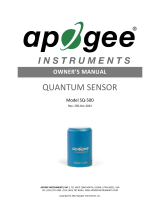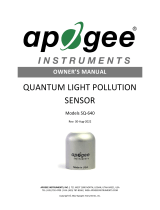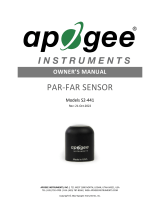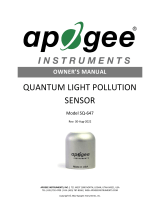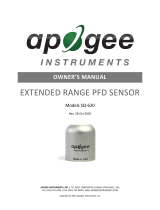Page is loading ...

APOGEE INSTRUMENTS, INC. | 721 WEST 1800 NORTH, LOGAN, UTAH 84321, USA
TEL: (435) 792-4700 | FAX: (435) 787-8268 | WEB: APOGEEINSTRUMENTS.COM
Copyright © 2022 Apogee Instruments, Inc.
OWNER’S MANUAL
RED - FAR-RED SENSORS
Models S2-131
Rev: 31-Aug-2022

TABLE OF CONTENTS
Owner’s Manual ............................................................................................................................................................................... 1
Certificates of Compliance ....................................................................................................................................................... 3
Introduction ............................................................................................................................................................................. 5
Sensor Models ......................................................................................................................................................................... 6
Specifications ........................................................................................................................................................................... 7
Deployment and Installation .................................................................................................................................................... 9
Cable Connectors ................................................................................................................................................................... 10
Operation and Measurement ................................................................................................................................................ 11
Maintenance and Recalibration ............................................................................................................................................. 13
Troubleshooting and Customer Support ................................................................................................................................ 14
Return and Warranty Policy ................................................................................................................................................... 15

CERTIFICATE OF COMPLIANCE
EU Declaration of Conformity
This declaration of conformity is issued under the sole responsibility of the manufacturer:
Apogee Instruments, Inc.
721 W 1800 N
Logan, Utah 84321
USA
for the following product(s):
Models: S2-131
Type: Red - Far-Red Sensors
The object of the declaration described above is in conformity with the relevant Union harmonization legislation:
2014/30/EU Electromagnetic Compatibility (EMC) Directive
2011/65/EU Restriction of Hazardous Substances (RoHS 2) Directive
2015/863/EU Amending Annex II to Directive 2011/65/EU (RoHS 3)
Standards referenced during compliance assessment:
EN 61326-1:2013 Electrical equipment for measurement, control, and laboratory use – EMC requirements
EN 63000:2018 Technical documentation for the assessment of electrical and electronic products with
respect to the restriction of hazardous substances
Please be advised that based on the information available to us from our raw material suppliers, the products
manufactured by us do not contain, as intentional additives, any of the restricted materials including lead (see
note below), mercury, cadmium, hexavalent chromium, polybrominated biphenyls (PBB), polybrominated
diphenyls (PBDE), bis (2-ethylhexyl) phthalate (DEHP), butyl benzyl phthalate (BBP), dibutyl phthalate (DBP), and
diisobutyl phthalate (DIBP). However, please note that articles containing greater than 0.1 % lead concentration
are RoHS 3 compliant using exemption 6c.
Further note that Apogee Instruments does not specifically run any analysis on our raw materials or end products
for the presence of these substances, but we rely on the information provided to us by our material suppliers.
Signed for and on behalf of:
Apogee Instruments, August 2022
Bruce Bugbee
President
Apogee Instruments, Inc.

CERTIFICATE OF COMPLIANCE
UK Declaration of Conformity
This declaration of conformity is issued under the sole responsibility of the manufacturer:
Apogee Instruments, Inc.
721 W 1800 N
Logan, Utah 84321
USA
for the following product(s):
Models: S2-131
Type: Red - Far-Red Sensors
The object of the declaration described above is in conformity with the relevant UK Statutory Instruments and
their amendments:
2016 No. 1091 The Electromagnetic Compatibility Regulations 2016
2012 No. 3032 The Restriction of the Use of Certain Hazardous Substances in Electrical and Electronic
Equipment Regulations 2012
Standards referenced during compliance assessment:
BS EN 61326-1:2013 Electrical equipment for measurement, control, and laboratory use – EMC requirements
BS EN 63000:2018 Technical documentation for the assessment of electrical and electronic products with
respect to the restriction of hazardous substances
Please be advised that based on the information available to us from our raw material suppliers, the products
manufactured by us do not contain, as intentional additives, any of the restricted materials including lead (see
note below), mercury, cadmium, hexavalent chromium, polybrominated biphenyls (PBB), polybrominated
diphenyls (PBDE), bis (2-ethylhexyl) phthalate (DEHP), butyl benzyl phthalate (BBP), dibutyl phthalate (DBP), and
diisobutyl phthalate (DIBP). However, please note that articles containing greater than 0.1 % lead concentration
are RoHS 3 compliant using exemption 6c.
Further note that Apogee Instruments does not specifically run any analysis on our raw materials or end products
for the presence of these substances, but we rely on the information provided to us by our material suppliers.
Signed for and on behalf of:
Apogee Instruments, August 2022
Bruce Bugbee
President
Apogee Instruments, Inc.

INTRODUCTION
Specific wavelengths of radiation trigger distinct responses in plants. Red and far-red wavelengths are of particular
interest because they influence photosynthetic and morphogenic activity. Phytochrome pigments in plants are
sensitive to varying ratios of red and far-red radiation, providing information to the plant about the light
environment, and therefore, optimal growth patterns. Increasing the fraction of red radiation indicates less
shading and generally results in more conservative vertical growth patterns, while increasing the far-red radiation
fraction indicates more shading and results in more aggressive vertical growth patterns.
Red - far-red sensors are designed to have spectral sensitivities that approximate the phytochrome absorption
spectrum. Red - far-red sensors quantify properties of radiation sources, not plant responses. However, inferences
of plant responses can be made from measurements of the lighting/shading environment, so it is important that
red - far-red sensors have high sensitivity in the wavelength ranges where plants are most sensitive (i.e., the
wavelength ranges that drive the strongest responses in plants), hence red - far-red sensor spectral responses
should approximate the phytochrome absorption spectrum.
The primary application of red - far-red sensors is monitoring plant light environments, including calculation of the
red to far-red ratio (red photon flux density / far-red photon flux density) and far-red fraction (far-red photon flux
density / sum of red and far-red photon flux densities), in photobiology studies (e.g., researching plant
morphogenic activities).
Apogee Instruments model S2-131 red - far-red sensors consist of a cast acrylic diffuser, pair of photodiodes that
measure specific wavelength ranges (red peak near the red peak of phytochrome absorption and far-red peak near
the far-red peak of phytochrome absorption), and signal processing circuitry mounted in an anodized aluminum
housing, and a cable to connect the radiometer to a measurement device. Sensors are designed for continuous
measurement in indoor and outdoor environments. Model S2-131 sensors output two voltages, one from each
photodetector, that are directly proportional to the radiation incident on a planar surface (does not have to be
horizontal), where the radiation emanates from all angles of a hemisphere.

SENSOR MODELS
This manual covers the analog output red - far-red sensor, model S2-131 (listed in bold below). Additional models
are covered in their respective manuals.
Model
Signal
S2-131
0-40 mV
S2-431
SDI-12
S2-432
Modbus
A sensor’s model number and serial number are
located on the bottom of the sensor. If the
manufacturing date of a specific sensor is
required, please contact Apogee Instruments
with the serial number of the sensor.

SPECIFICATIONS
Calibration Traceability
Apogee S2 series Red - Far-Red sensors are calibrated through side-by-side comparison to the mean of three
transfer standard sensors under a quartz halogen lamp. The transfer standard sensors are calibrated through side-
by-side comparison to red and far-red photon flux density calculated from solar spectra collected in Logan, Utah,
using an Apogee model PS-300 spectroradiometer. The PS-300 spectroradiometer is calibrated with a quartz
halogen lamp traceable to the National Institute of Standards and Technology (NIST).
S2-131
Power Supply
Self-powered
*Output (sensitivity)
0.08 mV per µmol m⁻² s⁻¹ (typical value, variable from sensor to sensor)
*Calibration Factor
(reciprocal of sensitivity)
12 µmol m⁻² s⁻¹ per mV (typical value, variable from sensor to sensor)
Calibration Uncertainty
± 5 %
*Output Range
0 to 33 mV
Measurement Repeatability
Less than 1 %
Long-term Drift
Less than 2 % per year
Non-linearity
Less than 1 % (up to 400 µmol m⁻² s⁻¹)
Response Time
Less than 1 ms
Field of View
180°
Wavelength Ranges
645 to 665 nm ± 5 nm (Red)
720 to 740 nm ± 5 nm (Far-red)
Directional (Cosine)
Response
± 2 % at 45°; ± 5 % at 75° zenith angle
Temperature Response
Less than 0.1 % per C
Housing
Anodized aluminum body with acrylic diffuser
IP Rating
IP68
Operating Environment
-40 to 70 C; 0 to 100 % relative humidity
Dimensions
30.5 mm diameter, 37 mm height
Mass (with 5 m of cable)
140 g
Cable
5 m of shielded, twisted-pair wire; TPR jacket (high water resistance, high UV stability, flexibility
in cold conditions); pigtail lead wires; stainless steel (316), M8 connector
*The Ouput, Calibration Factor, and Output Range are variable from sensor to sensor, and the specifications listed are typical
values.

Directional (Cosine) Response
Spectral Response
Directional (cosine) response is defined as
the measurement error at a specific angle of
radiation incidence. Error for Apogee S2
series red / far sensors is approximately ± 2
% and ± 5 % at solar zenith angles of 45° and
75°, respectively.
Mean spectral response measurements
of six replicate red - far-red sensors (red
sensor is centered near 655 nm, far-red
sensor is centered near 730 nm).
Spectral response measurements were
made at 2 nm increments across a
wavelength range of 600 to 800 nm in a
monochromator with an attached
electric light source. Measured spectral
data from each sensor were normalized
by the measured spectral response of
the monochromator/electric light
combination, which was measured with
a spectroradiometer.

DEPLOYMENT AND INSTALLATION
Mount the sensor to a solid surface with the nylon mounting screw provided to prevent galvanic corrosion. To
accurately measure red and far-red photon flux density incident on a horizontal surface, the sensor must be level.
An Apogee Instruments model AL-100 Leveling Plate is recommended to level the sensor when used on a flat
surface or being mounted to surfaces such as wood. To facilitate mounting on a mast or pipe, the Apogee
Instruments model AL-120 Solar Mounting Bracket with Leveling Plate is recommended.
To minimize azimuth error, the sensor should be mounted with the cable pointing toward true north in the
northern hemisphere or true south in the southern hemisphere. Azimuth error is typically less than 1 %, but it is
easy to minimize by proper cable orientation.
In addition to orienting the cable to point toward the nearest pole, the sensor should also be mounted such that
obstructions (e.g., weather station tripod/tower or other instrumentation) do not shade the sensor. Once
mounted, the green cap should be removed from the sensor. The green cap can be used as a protective covering
for the sensor when it is not in use.
Nylon Screw: 10-32x3/8
Nylon Screw: 10-32x3/8
Model AL-120
Model AL-100

CABLE CONNECTORS
Apogee sensors offer cable connectors to simplify the
process of removing sensors from weather stations
for calibration (the entire cable does not have to be
removed from the station and shipped with the
sensor).
The ruggedized M8 connectors are rated IP68, made
of corrosion-resistant marine-grade stainless-steel,
and designed for extended use in harsh
environmental conditions.
Inline cable connectors are installed 30 cm from the
sensor head (pyranometer pictured).
Instructions
Pins and Wiring Colors: All Apogee connectors
have six pins, but not all pins are used for every
sensor. There may also be unused wire colors
inside the cable. To simplify connection to a
measurement device, the unused pigtail lead
wire colors are removed.
If a replacement cable is required, please contact
Apogee directly to ensure ordering the proper
pigtail configuration.
Alignment: When reconnecting a sensor, arrows
on the connector jacket and an aligning notch
ensure proper orientation.
Disconnection for extended periods: When
disconnecting the sensor for an extended period
of time from an installation, protect the
remaining half of the connector still on the
station from water and dirt with electrical tape or
other method.
A reference notch inside the connector ensures
proper alignment before tightening.
When sending sensors back for recalibration, only send the
section of cable that is hard-wired to the sensor. The
section of cable with the pigtail is not required.
Tightening: Connectors are designed to be firmly
finger-tightened only. There is an O-ring inside
the connector that can be overly compressed if a
wrench is used. Pay attention to thread
alignment to avoid cross-threading. When fully
tightened, one to two threads may still be visible.
WARNING: Do not tighten the connector by
twisting the black cable, only twist the metal
connector.
Finger-tighten firmly.

OPERATION AND MEASUREMENT
Connect the sensor to a measurement device (meter, datalogger, controller) capable of measuring and displaying
or recording a millivolt signal (an input measurement range of approximately 0 to 12.5 mV is required to cover the
entire range of red and far-red photon flux density from the sun). In order to maximize measurement resolution
and signal-to-noise ratio, the input range of the measurement device should closely match the output range of the
quantum sensor. DO NOT connect the sensor to a power source. The sensor is self-powered and applying voltage
will damage the sensor.
Wiring for S2-131
Yellow: Positive (signal from red sensor)
Blue: Negative (signal from red sensor)
White: Positive (signal from far-red sensor)
Black: Negative (signal from far-red sensor)
Clear: Shield

Sensor Calibration
The Apogee unamplified red - far-red sensor model S2-131 has approximate calibration factors of for the red and
far-red sensors:
12 mol m-2 s-1 per mV
Multiply the calibration factors by the measured voltages to convert sensor outputs to red and far-red photon flux
densities (PFD) in units of mol m-2 s-1:
Calibration Factor (12 mol m-2 s-1 per mV) * Sensor Output Signal (mV) = Red PFD (mol m-2 s-1)
12 * 12.5 = 150
Calibration Factor (12 mol m-2 s-1 per mV) * Sensor Output Signal (mV) = Far-Red PFD (mol m-2 s-1)
12 * 11.3 = 136
Example of red photon flux density (PFD)
measurement with an Apogee red - far-red
sensor. Full sunlight yields a red PFD on a
horizontal plane at the Earth’s surface of
approximately 150 mol m-2 s-1. This yields an
output signal of 12.5 mV. The signal is
converted to red PFD by multiplying by the
calibration factor of 12 mol m-2 s-1 per mV.
Sensor Output
12.5 mV
Full Sunlight
(150 mol m-2 s-1)

MAINTENANCE AND RECALIBRATION
Blocking of the optical path between the target and detector can cause low readings. Occasionally, accumulated
materials on the diffuser of the sensor can block the optical path in three common ways:
1. Moisture or debris on the diffuser.
2. Dust during periods of low rainfall.
3. Salt deposit accumulation from evaporation of sea spray or sprinkler irrigation water.
Apogee Instruments Red - Far-Red sensors have a domed diffuser and housing for improved self-cleaning from
rainfall, but active cleaning may be necessary. Dust or organic deposits are best removed using water, or window
cleaner, and a soft cloth or cotton swab. Salt deposits should be dissolved with vinegar and removed with a cloth
or cotton swab. Salt deposits cannot be removed with solvents such as alcohol or acetone. Use only gentle
pressure when cleaning the diffuser with a cotton swab or soft cloth, to avoid scratching the outer surface. The
solvent should be allowed to do the cleaning, not mechanical force. Never use an abrasive material or abrasive
cleaner on the diffuser.
Although Apogee sensors are very stable, nominal calibration drift is normal for all research-grade sensors. To
ensure maximum accuracy, recalibration every two years is recommended. Longer time periods between
recalibration may be warranted depending on tolerances. See the Apogee webpage for details regarding return of
sensors for recalibration (http://www.apogeeinstruments.com/tech-support-recalibration-repairs/).
As a general reference, red photon flux density is approximately 145-160 mol m-2 s-1 and far-red photon flux
density is approximately 130-145 mol m-2 s-1 on a clear summer day near solar noon, yielding a red / far-red ratio
near 1.1.

TROUBLESHOOTING AND CUSTOMER SUPPORT
Independent Verification of Functionality
Apogee model S2-131 red - far-red sensors are self-powered devices and output two voltages, proportional to red
and far-red photon flux density (PFD), respectively. A quick and easy check of sensor functionality can be
determined using a voltmeter with millivolt resolution. To verify the red sensor, connect the positive lead wire
from the voltmeter to the yellow wire from the sensor and the negative (or common) lead wire from the voltmeter
to the blue wire from the sensor. Direct the sensor head toward a light source and verify the sensor provides a
signal. Increase and decrease the distance from the sensor head to the light source to verify that the signal
changes proportionally (decreasing signal with increasing distance and increasing signal with decreasing distance).
Blocking all radiation from the sensor should force the sensor signal to zero. To verify the far-red sensor, follow the
same procedure, but connect the positive lead wire from the voltmeter to the white wire from the sensor and the
negative lead wire from the voltmeter to the black wire from the sensor.
Compatible Measurement Devices (Dataloggers/Controllers/Meters)
S2-131 series red - far-red sensors are calibrated with a calibration factor of approximately 12 mol m-2 s-1 per mV
(typical value, variable from sensor to sensor), yielding sensitivities of 0.083 mV per mol m-2 s-1 for the red and
far-red sensors. Thus, a compatible measurement device (e.g., datalogger or controller) should have resolution of
at least 0.08 mV in order to provide red and far-red photon flux density resolution of 1 mol m-2 s-1 and 0.008 mV
in order to provide red and far-red photon flux density resolution of 0.1 mol m-2 s-1
An example datalogger program for Campbell Scientific dataloggers can be found on the Apogee webpage
(https://www.apogeeinstruments.com/content/Red-Far-Red-Sensor.CR1).
Cable Length
When the sensor is connected to a measurement device with high input impedance, sensor output signals are not
changed by shortening the cable or splicing on additional cable in the field. Tests have shown that if the input
impedance of the measurements device is greater than 1 mega-ohm there is negligible effect on the calibration,
even after adding up to 100 m of cable. All Apogee sensors use shielded, twisted pair cable to minimize
electromagnetic interference. For best measurements, the shield wire must be connected to an earth ground. This
is particularly important when using the sensor with long lead lengths in electromagnetically noisy environments.
Modifying Cable Length
See Apogee webpage for details on how to extend sensor cable length (http://www.apogeeinstruments.com/how-
to-make-a-weatherproof-cable-splice/).

RETURN AND WARRANTY POLICY
RETURN POLICY
Apogee Instruments will accept returns within 30 days of purchase as long as the product is in new condition (to be
determined by Apogee). Returns are subject to a 10 % restocking fee.
WARRANTY POLICY
What is Covered
All products manufactured by Apogee Instruments are warranted to be free from defects in materials and craftsmanship
for a period of four (4) years from the date of shipment from our factory. To be considered for warranty coverage an
item must be evaluated by Apogee.
Products not manufactured by Apogee (spectroradiometers, chlorophyll content meters, EE08-SS probes) are covered
for a period of one (1) year.
What is Not Covered
The customer is responsible for all costs associated with the removal, reinstallation, and shipping of suspected warranty
items to our factory.
The warranty does not cover equipment that has been damaged due to the following conditions:
1. Improper installation, use, or abuse.
2. Operation of the instrument outside of its specified operating range.
3. Natural occurrences such as lightning, fire, etc.
4. Unauthorized modification.
5. Improper or unauthorized repair.
Please note that nominal accuracy drift is normal over time. Routine recalibration of sensors/meters is considered part of
proper maintenance and is not covered under warranty.
Who is Covered
This warranty covers the original purchaser of the product or other party who may own it during the warranty period.
What Apogee Will Do
At no charge Apogee will:
1. Either repair or replace (at our discretion) the item under warranty.
2. Ship the item back to the customer by the carrier of our choice.
Different or expedited shipping methods will be at the customer’s expense.

APOGEE INSTRUMENTS, INC. | 721 WEST 1800 NORTH, LOGAN, UTAH 84321, USA
TEL: (435) 792-4700 | FAX: (435) 787-8268 | WEB: APOGEEINSTRUMENTS.COM
Copyright © 2022 Apogee Instruments, Inc.
How To Return An Item
1. Please do not send any products back to Apogee Instruments until you have received a Return Merchandise
Authorization (RMA) number from our technical support department by submitting an online RMA form at
www.apogeeinstruments.com/tech-support-recalibration-repairs/. We will use your RMA number for tracking of the
service item. Call (435) 245-8012 or email techsupport@apogeeinstruments.com with questions.
2. For warranty evaluations, send all RMA sensors and meters back in the following condition: Clean the sensor’s exterior
and cord. Do not modify the sensors or wires, including splicing, cutting wire leads, etc. If a connector has been attached
to the cable end, please include the mating connector – otherwise the sensor connector will be removed in order to
complete the repair/recalibration. Note: When sending back sensors for routine calibration that have Apogee’s standard
stainless-steel connectors, you only need to send the sensor with the 30 cm section of cable and one-half of the
connector. We have mating connectors at our factory that can be used for calibrating the sensor.
3. Please write the RMA number on the outside of the shipping container.
4. Return the item with freight pre-paid and fully insured to our factory address shown below. We are not responsible for
any costs associated with the transportation of products across international borders.
Apogee Instruments, Inc.
721 West 1800 North Logan, UT
84321, USA
5. Upon receipt, Apogee Instruments will determine the cause of failure. If the product is found to be defective in terms
of operation to the published specifications due to a failure of product materials or craftsmanship, Apogee Instruments
will repair or replace the items free of charge. If it is determined that your product is not covered under warranty, you
will be informed and given an estimated repair/replacement cost.
PRODUCTS BEYOND THE WARRANTY PERIOD
For issues with sensors beyond the warranty period, please contact Apogee at techsupport@apogeeinstruments.com to
discuss repair or replacement options.
OTHER TERMS
The available remedy of defects under this warranty is for the repair or replacement of the original product, and Apogee
Instruments is not responsible for any direct, indirect, incidental, or consequential damages, including but not limited to
loss of income, loss of revenue, loss of profit, loss of data, loss of wages, loss of time, loss of sales, accruement of debts
or expenses, injury to personal property, or injury to any person or any other type of damage or loss.
This limited warranty and any disputes arising out of or in connection with this limited warranty ("Disputes") shall be
governed by the laws of the State of Utah, USA, excluding conflicts of law principles and excluding the Convention for the
International Sale of Goods. The courts located in the State of Utah, USA, shall have exclusive jurisdiction over any
Disputes.
This limited warranty gives you specific legal rights, and you may also have other rights, which vary from state to state
and jurisdiction to jurisdiction, and which shall not be affected by this limited warranty. This warranty extends only to
you and cannot by transferred or assigned. If any provision of this limited warranty is unlawful, void, or unenforceable,
that provision shall be deemed severable and shall not affect any remaining provisions. In case of any inconsistency
between the English and other versions of this limited warranty, the English version shall prevail.
This warranty cannot be changed, assumed, or amended by any other person or agreement
/
